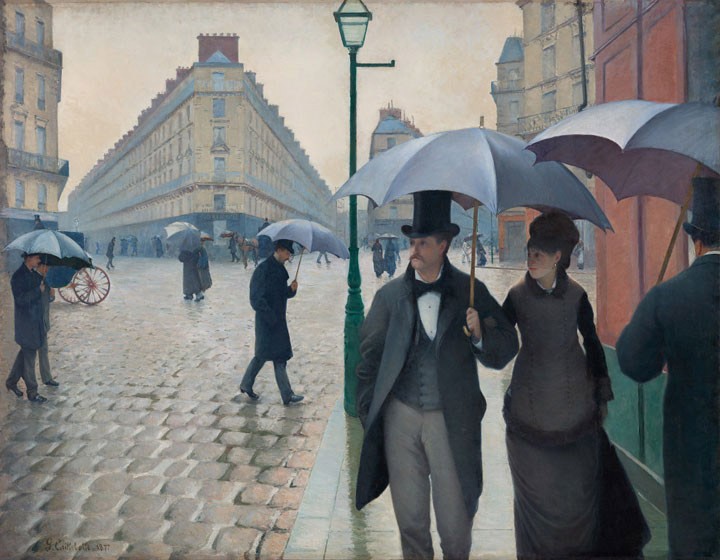As a Chicagoan, I have had the great pleasure of living with Caillebotte’s Paris, Rainy Day for 30 years. It is one of my favorite paintings, since it combines two of my particular interests in art: on the one hand, the left of the painting has that incredible vista down the street, which, as someone who works mostly on architectural history, is a tantalizing view into what people like Caillebotte thought of their new city streets; on the other, the couple on the right, pushed so obviously into our space, speaks to Caillebotte’s interest in representing class, gender relations, and social history. But it wasn’t until I saw the painting after it was recently cleaned and then further considered it in light of the current exhibition that I became mindful of other ways of seeing this painting in particular and the artist’s work more generally.
What, after all, is one to do with all those people looking? After the cleaning, I was struck by how clearly the gaze of the large bourgeois man in the foreground crosses over the red kerchief of the working-class woman walking away from us in the background. The red of that kerchief just wasn’t that obvious until recently. But since red as a color attracts our eye (known to artists and used by almost every culture), that woman and her companion, placed so significantly in the middle of the composition, took on new prominence. Is the man also secretly drawn to this working-class woman, as we are? Or, conversely, are we looking past her, to the city and its spaces, just as the bourgeois couple seem to look past the individuals around them? (I also noted the other workers so clearly articulated by Caillebotte behind, but of no interest to, our fashionable friends.) Spaces and gazes seem to be much more important than I had ever realized.
And then I looked at the painting’s companions: the couple (or are they?) on the The Pont de l’Europe or the seemingly heroic painters working on a facade. Suddenly, I was more conscious of where these people are looking. I was noting the empty spaces and all of those gazes that just seem to be everywhere here. In my first pass at the exhibition, I began to look at how Caillebotte’s subjects were themselves seemingly constantly looking at things and spaces and people. Perhaps modern life and modern spaces are about things to be seen and people to see them? But what are they looking at? Empty spaces? Fashionable people? Workers blending into the background? As usual with this artist, I return again and again to the fascinating and important questions of social history and the spaces of modern life.
Paul B. Jaskot
Andrew W. Mellon Professor/CASVA

